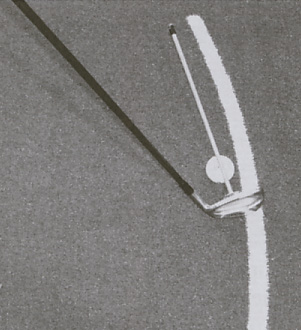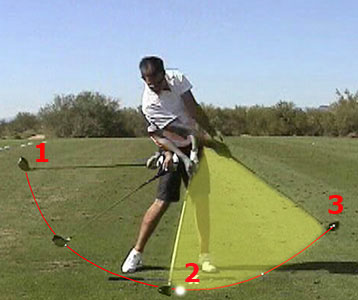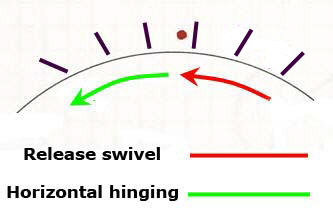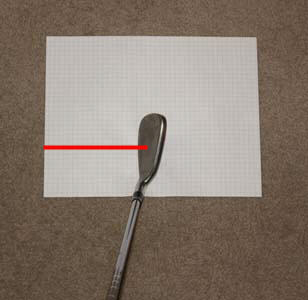Matt Bryda
New
swing line
its the gutter on the roof of a house extending in both directions to infinity
its the gutter on the roof of a house extending in both directions to infinity
is all the above dependent on your lie angles of your clubs being correct? Also
(The ball will start ~70-85% of the way to the TRUE CLUBFACE, and then curve—UP THE PLANE, toward the TRUE CLUBFACE). is this correct ?

Holeout - you wrote-: ""Swing left" in this case means that your "swing line" (Manzella term)/ "plane line" (TGM term) should be aimed 7 yards left of target. Simple as that."
It doesn't seem as simple as that to me and it still doesn't make sense to me.
I can understand that one would need to shift the plane line left by 2.67 degrees to counteract the fact that the clubhead is moving down-and-out by 2.67 degrees - if the clubface was directed in exactly the same direction as the clubshaft hosel (like a tennis racket). However, the clubface has a hook-face alignment relative to the front of the hosel, and if one swings the front of the hosel 2.67 degrees down-and-out (relative to the direction of any selected plane line), it doesn't mean that the clubface is also directed 2.67 degrees right of the selected plane line.
Jeff.
Detonum
You wrote-: "I don't see how the face couldn't be square to the target even with a hook faced club."
That's my problem - it isn't clear to me that the clubface will be square to the target just because the clubhead is square to the target.
Here is an experiment for you - place a golf ball on a 30-45 degree grass upslope (side-hill lie). Using an eight iron, swing the clubhead towards a distance target (ensuring that the back of the left hand faces the target at impact) and see where the ball goes. Then repeat the experiment on a 30 degree downslope with the ball below your feet, and ensure that the back of the left hand faces the target at impact. See where the ball goes.
According to your expectations - if the clubface was really square to the target when the clubhead is square to the target at impact, then the ball should go straight towards the target in both situations.
Jeff.
...the fact that you made such a concerted effort to explain why-: "You need to AIM and (or) SWING ~2.67° at 150 yards....which is ~7 yards left of the target" when hitting an 8-iron 150 yards to get the ball to go straight.
However, I cannot understand what you mean when you state that a golfer has to swing 2.67 degrees left of the target. What is being swung left of the target?

From my perspective, a golfer swings the clubshaft and I believe that the clubshaft hosel should generate an in-to-square-to-in path through the impact zone.
Attached to the clubshaft hosel is a clubhead, and the clubhead will swivel into impact during the release swivel phase of the downswing.
If the downswing release swivel release phase is perfected (perfect release of PA#3) then the clubhead will become square at impact (neither over-rolled or under-rolled) from a horizontal plane perspective. I do not see where your model takes into account the release swivel action (release of PA#3).
I can mentally picture the clubshaft hosel, and therefore attached clubhead, moving down-and-out according to your calculations. So, when you state that "Lets say you hit down 4° at 60° with a 8-iron.....you are also hitting "out" ~2.67°", I can accept/understand that the hosel is moving outwards and not only downwards, and I can mentally picture the hosel moving out 2.67 degrees at impact (or just pre-impact).
However, I believe that the clubface is closed due to its inbuilt manufacturing specifications, which means that the clubface is automatically open (facing leftwards) relative to the hosel/clubhead swingpath by "X" degrees through impact.
You stated that a hookface only means that the sweetspot is being behind the centerline, and you do not seemingly believe that the hookface alignment of the clubface also indicates that the clubface is directed leftwards.
I believe that the clubface is directed leftwards (relative to the hosel/clubhead), and it allows the ball to go straight when the hosel/clubhead swing path is outwards (moving right-of-the-target).
I therefore cannot understand why the hosel/clubhead must be aimed/swung leftwards to hit the ball straight - if anybody would suggest that it is the hosel/clubhead that must be aimed/swung leftwards. Or is it "something else" that must be aimed/swung leftwards?
That's my problem - it isn't clear to me that the clubface will be square to the target just because the clubhead is square to the target.
Here is an experiment for you - place a golf ball on a 30-45 degree grass upslope (side-hill lie). Using an eight iron, swing the clubhead towards a distance target (ensuring that the back of the left hand faces the target at impact) and see where the ball goes. Then repeat the experiment on a 30 degree downslope with the ball below your feet, and ensure that the back of the left hand faces the target at impact. See where the ball goes.
According to your expectations - if the clubface was really square to the target when the clubhead is square to the target at impact, then the ball should go straight towards the target in both situations.
You wrote-: "With a vertical plane angle, you could play a straight shot with a plane line parallel to the target line, no matter how much you hit down or up."
When you state "vertical plane angle" are you implying that the clubshaft will be moving along a plane that is vertical to the ground throughout the downswing and moving like a ferris-wheel, and are you thereby implying that the clubface will be facing the target at impact if the clubshaft is near-vertical to the ground at impact?




I believe that it is easy for a skilled golfer to hit the ball straight without aiming left/swinging left. My brother, Howard, has a handicap of 1.3 and he routinely hits his 260-280 yard drives straight down the middle of the fairway, and he hits his 8-iron straight towards the flag. His ball flight is straight and he doesn't draw/fade the ball. How does he hit the ball straight if he doesn't aim left/swing left?
The following photo shows the club's optimum position at impact (actually at the exact moment of ball-clubface separation).


